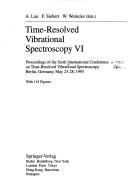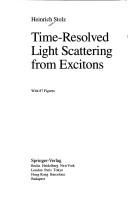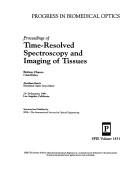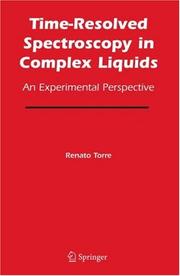| Listing 1 - 10 of 10 |
Sort by
|
Book
Abstract | Keywords | Export | Availability | Bookmark
 Loading...
Loading...Choose an application
- Reference Manager
- EndNote
- RefWorks (Direct export to RefWorks)

ISBN: 9780387575735 0387575731 Year: 1994 Publisher: Berlin: Springer,
Abstract | Keywords | Export | Availability | Bookmark
 Loading...
Loading...Choose an application
- Reference Manager
- EndNote
- RefWorks (Direct export to RefWorks)
Time-resolved spectroscopy --- Vibrational spectra --- Raman spectroscopy

ISBN: 354057946X 3540483950 9783540579465 Year: 1994 Volume: 130 Publisher: Berlin Springer
Abstract | Keywords | Export | Availability | Bookmark
 Loading...
Loading...Choose an application
- Reference Manager
- EndNote
- RefWorks (Direct export to RefWorks)
Experimental solid state physics --- Optics. Quantum optics --- Exciton theory --- Light --- Time-resolved spectroscopy --- Scattering --- Light - Scattering

ISBN: 0819405213 9780819405210 Year: 1991 Publisher: Bellingham, Wash. Society of Photo-optical Instrumentation Engineers
Abstract | Keywords | Export | Availability | Bookmark
 Loading...
Loading...Choose an application
- Reference Manager
- EndNote
- RefWorks (Direct export to RefWorks)
Time-resolved spectroscopy --- Imaging systems in medicine --- Diagnostic Imaging --- Radiation --- Spectrophotometry --- methods --- Conferences - Meetings
Book
ISBN: 9781498716734 9780429440823 Year: 2018 Publisher: Boca Raton : CRC Press, Taylor & Francis Group,
Abstract | Keywords | Export | Availability | Bookmark
 Loading...
Loading...Choose an application
- Reference Manager
- EndNote
- RefWorks (Direct export to RefWorks)
This concise and carefully developed text offers a reader friendly guide to the basics of time-resolved spectroscopy with an emphasis on experimental implementation. The authors carefully explain and relate for the reader how measurements are connected to the core physical principles. They use the time-dependent wave packet as a building block for understanding quantum dynamics, progressively advancing to more complex topics. The topics are discussed in paired sections, one discussing the theory and the next presenting the related experimental methods.A wide range of readers including students and newcomers to the field will gain a clear and practical understanding of how to measure aspects of molecular dynamics such as wave packet motion, intramolecular vibrational relaxation, and electron-electron coupling, and how to describe such measurements mathematically.
Time-resolved spectroscopy. --- Spectrum analysis. --- Spectroscopie résolue en temps. --- Spectroscopie.
Book
ISBN: 0306414767 1475716362 1475716346 Year: 1983 Volume: vol 69 Publisher: New York London Plenum Press
Abstract | Keywords | Export | Availability | Bookmark
 Loading...
Loading...Choose an application
- Reference Manager
- EndNote
- RefWorks (Direct export to RefWorks)
Biological techniques --- Analytical biochemistry --- Biochemistry --- -Biology --- -Fluorescence spectroscopy --- -Time-resolved spectroscopy --- -Spectrometry, Time-resolved --- Spectroscopy, Time-resolved --- Time-resolved laser spectroscopy --- Laser spectroscopy --- Fluorescence spectrometry --- Spectrometry, Fluorescence --- Spectroscopy, Fluorescence --- Luminescence spectroscopy --- Fluorescent probes --- Life sciences --- Biomass --- Life (Biology) --- Natural history --- Biological chemistry --- Chemical composition of organisms --- Organisms --- Physiological chemistry --- Biology --- Chemistry --- Medical sciences --- Technique --- -Congresses --- Congresses --- Composition --- Fluorescence spectroscopy --- Time-resolved spectroscopy --- Congresses. --- -Technique --- Spectrometry, Time-resolved --- Technique&delete&
Book
Year: 2020 Publisher: Basel, Switzerland MDPI - Multidisciplinary Digital Publishing Institute
Abstract | Keywords | Export | Availability | Bookmark
 Loading...
Loading...Choose an application
- Reference Manager
- EndNote
- RefWorks (Direct export to RefWorks)
Jöbsis was the first to describe the in vivo application of near-infrared spectroscopy (NIRS), also called diffuse optical spectroscopy (DOS). NIRS was originally designed for the clinical monitoring of tissue oxygenation, and today it has also become a useful tool for neuroimaging studies (functional near-infrared spectroscopy, fNIRS). However, difficulties in the selective and quantitative measurements of tissue hemoglobin (Hb), which have been central in the NIRS field for over 40 years, remain to be solved. To overcome these problems, time-domain (TD) and frequency-domain (FD) measurements have been tried. Presently, a wide range of NIRS instruments are available, including commonly available commercial instruments for continuous wave (CW) measurements, based on the modified Beer–Lambert law (steady-state domain measurements). Among these measurements, the TD measurement is the most promising approach, although compared with CW and FD measurements, TD measurements are less common, due to the need for large and expensive instruments with poor temporal resolution and limited dynamic range. However, thanks to technological developments, TD measurements are increasingly being used in research, and also in various clinical settings. This Special Issue highlights issues at the cutting edge of TD DOS and diffuse optical tomography (DOT). It covers all aspects related to TD measurements, including advances in hardware, methodology, the theory of light propagation, and clinical applications.
Medicine --- Neurosciences --- breast cancer --- diffuse optical spectroscopy --- chemotherapy --- time-domain spectroscopy --- near-infrared spectroscopy --- radiative transfer equation --- diffusion equation --- biological tissue --- time-domain instruments --- light propagation in tissue --- optical properties of tissue --- diffuse optical tomography --- fluorescence diffuse optical tomography --- time-resolved spectroscopy --- NIRS --- diffuse optics --- time-domain --- time-resolved --- brain oxygenation --- tissue saturation --- scattering --- absorption --- 3-hour sitting --- near infrared time-resolved spectroscopy --- compression stocking --- tissue oxygenation --- extracellular water --- intracellular water --- circumference --- gastrocnemius --- neonate --- vaginal delivery --- cerebral blood volume --- cerebral hemoglobin oxygen saturation --- near-infrared time-resolved spectroscopy --- near infrared spectroscopy --- aging --- prefrontal cortex --- TRS --- magnetic resonance imaging --- brain atrophy --- VSRAD --- optical pathlength --- hemoglobin --- cognitive function --- time-domain NIRS --- null source-detector separation --- brain --- noninvasive --- subcutaneous white adipose tissue --- tissue total hemoglobin --- diffuse light --- inverse problems --- optical tomography --- inverse problem --- datatypes --- diffusion approximation --- highly forward scattering of photons --- diffusion and delta-Eddington approximations --- characteristic length and time scales of photon transport --- n/a
Book
Year: 2020 Publisher: Basel, Switzerland MDPI - Multidisciplinary Digital Publishing Institute
Abstract | Keywords | Export | Availability | Bookmark
 Loading...
Loading...Choose an application
- Reference Manager
- EndNote
- RefWorks (Direct export to RefWorks)
Jöbsis was the first to describe the in vivo application of near-infrared spectroscopy (NIRS), also called diffuse optical spectroscopy (DOS). NIRS was originally designed for the clinical monitoring of tissue oxygenation, and today it has also become a useful tool for neuroimaging studies (functional near-infrared spectroscopy, fNIRS). However, difficulties in the selective and quantitative measurements of tissue hemoglobin (Hb), which have been central in the NIRS field for over 40 years, remain to be solved. To overcome these problems, time-domain (TD) and frequency-domain (FD) measurements have been tried. Presently, a wide range of NIRS instruments are available, including commonly available commercial instruments for continuous wave (CW) measurements, based on the modified Beer–Lambert law (steady-state domain measurements). Among these measurements, the TD measurement is the most promising approach, although compared with CW and FD measurements, TD measurements are less common, due to the need for large and expensive instruments with poor temporal resolution and limited dynamic range. However, thanks to technological developments, TD measurements are increasingly being used in research, and also in various clinical settings. This Special Issue highlights issues at the cutting edge of TD DOS and diffuse optical tomography (DOT). It covers all aspects related to TD measurements, including advances in hardware, methodology, the theory of light propagation, and clinical applications.
breast cancer --- diffuse optical spectroscopy --- chemotherapy --- time-domain spectroscopy --- near-infrared spectroscopy --- radiative transfer equation --- diffusion equation --- biological tissue --- time-domain instruments --- light propagation in tissue --- optical properties of tissue --- diffuse optical tomography --- fluorescence diffuse optical tomography --- time-resolved spectroscopy --- NIRS --- diffuse optics --- time-domain --- time-resolved --- brain oxygenation --- tissue saturation --- scattering --- absorption --- 3-hour sitting --- near infrared time-resolved spectroscopy --- compression stocking --- tissue oxygenation --- extracellular water --- intracellular water --- circumference --- gastrocnemius --- neonate --- vaginal delivery --- cerebral blood volume --- cerebral hemoglobin oxygen saturation --- near-infrared time-resolved spectroscopy --- near infrared spectroscopy --- aging --- prefrontal cortex --- TRS --- magnetic resonance imaging --- brain atrophy --- VSRAD --- optical pathlength --- hemoglobin --- cognitive function --- time-domain NIRS --- null source-detector separation --- brain --- noninvasive --- subcutaneous white adipose tissue --- tissue total hemoglobin --- diffuse light --- inverse problems --- optical tomography --- inverse problem --- datatypes --- diffusion approximation --- highly forward scattering of photons --- diffusion and delta-Eddington approximations --- characteristic length and time scales of photon transport --- n/a
Book
Year: 2020 Publisher: Basel, Switzerland MDPI - Multidisciplinary Digital Publishing Institute
Abstract | Keywords | Export | Availability | Bookmark
 Loading...
Loading...Choose an application
- Reference Manager
- EndNote
- RefWorks (Direct export to RefWorks)
Jöbsis was the first to describe the in vivo application of near-infrared spectroscopy (NIRS), also called diffuse optical spectroscopy (DOS). NIRS was originally designed for the clinical monitoring of tissue oxygenation, and today it has also become a useful tool for neuroimaging studies (functional near-infrared spectroscopy, fNIRS). However, difficulties in the selective and quantitative measurements of tissue hemoglobin (Hb), which have been central in the NIRS field for over 40 years, remain to be solved. To overcome these problems, time-domain (TD) and frequency-domain (FD) measurements have been tried. Presently, a wide range of NIRS instruments are available, including commonly available commercial instruments for continuous wave (CW) measurements, based on the modified Beer–Lambert law (steady-state domain measurements). Among these measurements, the TD measurement is the most promising approach, although compared with CW and FD measurements, TD measurements are less common, due to the need for large and expensive instruments with poor temporal resolution and limited dynamic range. However, thanks to technological developments, TD measurements are increasingly being used in research, and also in various clinical settings. This Special Issue highlights issues at the cutting edge of TD DOS and diffuse optical tomography (DOT). It covers all aspects related to TD measurements, including advances in hardware, methodology, the theory of light propagation, and clinical applications.
Medicine --- Neurosciences --- breast cancer --- diffuse optical spectroscopy --- chemotherapy --- time-domain spectroscopy --- near-infrared spectroscopy --- radiative transfer equation --- diffusion equation --- biological tissue --- time-domain instruments --- light propagation in tissue --- optical properties of tissue --- diffuse optical tomography --- fluorescence diffuse optical tomography --- time-resolved spectroscopy --- NIRS --- diffuse optics --- time-domain --- time-resolved --- brain oxygenation --- tissue saturation --- scattering --- absorption --- 3-hour sitting --- near infrared time-resolved spectroscopy --- compression stocking --- tissue oxygenation --- extracellular water --- intracellular water --- circumference --- gastrocnemius --- neonate --- vaginal delivery --- cerebral blood volume --- cerebral hemoglobin oxygen saturation --- near-infrared time-resolved spectroscopy --- near infrared spectroscopy --- aging --- prefrontal cortex --- TRS --- magnetic resonance imaging --- brain atrophy --- VSRAD --- optical pathlength --- hemoglobin --- cognitive function --- time-domain NIRS --- null source-detector separation --- brain --- noninvasive --- subcutaneous white adipose tissue --- tissue total hemoglobin --- diffuse light --- inverse problems --- optical tomography --- inverse problem --- datatypes --- diffusion approximation --- highly forward scattering of photons --- diffusion and delta-Eddington approximations --- characteristic length and time scales of photon transport --- breast cancer --- diffuse optical spectroscopy --- chemotherapy --- time-domain spectroscopy --- near-infrared spectroscopy --- radiative transfer equation --- diffusion equation --- biological tissue --- time-domain instruments --- light propagation in tissue --- optical properties of tissue --- diffuse optical tomography --- fluorescence diffuse optical tomography --- time-resolved spectroscopy --- NIRS --- diffuse optics --- time-domain --- time-resolved --- brain oxygenation --- tissue saturation --- scattering --- absorption --- 3-hour sitting --- near infrared time-resolved spectroscopy --- compression stocking --- tissue oxygenation --- extracellular water --- intracellular water --- circumference --- gastrocnemius --- neonate --- vaginal delivery --- cerebral blood volume --- cerebral hemoglobin oxygen saturation --- near-infrared time-resolved spectroscopy --- near infrared spectroscopy --- aging --- prefrontal cortex --- TRS --- magnetic resonance imaging --- brain atrophy --- VSRAD --- optical pathlength --- hemoglobin --- cognitive function --- time-domain NIRS --- null source-detector separation --- brain --- noninvasive --- subcutaneous white adipose tissue --- tissue total hemoglobin --- diffuse light --- inverse problems --- optical tomography --- inverse problem --- datatypes --- diffusion approximation --- highly forward scattering of photons --- diffusion and delta-Eddington approximations --- characteristic length and time scales of photon transport

ISBN: 1281137553 9786611137557 0387255583 0387255575 1441938036 Year: 2008 Publisher: New York : Springer,
Abstract | Keywords | Export | Availability | Bookmark
 Loading...
Loading...Choose an application
- Reference Manager
- EndNote
- RefWorks (Direct export to RefWorks)
Time-Resolved Spectroscopy in Complex Liquids introduces current state-of-the-art techniques in the study of complex dynamical problems in liquid phases. With a unique focus on the experimental aspects applied to complex liquids, this volume provides an excellent overview into the quickly emerging field of soft-matter science. Researchers and engineers will find a comprehensive review of current non-linear spectroscopic and optical Kerr effect techniques, in addition to an in-depth look into relaxation dynamics in complex liquids. This volume offers current experimental findings in transient grating spectroscopy and their application to viscoelastic phenomena in glass-formers, dynamics of confined liquid-crystals, and a time-resolved analysis of the host-quest interactions of dye molecules in liquid-crystal matter. Time-Resolved Spectroscopy in Complex Liquids provides a cohesive introduction suitable for individuals involved in this emerging field, complete with the latest experimental procedures of complex liquids.
Complex fluids. --- Time-resolved spectroscopy. --- Fluid dynamics. --- Complex liquids --- Fluids, Complex --- Amorphous substances --- Liquids --- Dynamics --- Fluid mechanics --- Spectrometry, Time-resolved --- Spectroscopy, Time-resolved --- Time-resolved laser spectroscopy --- Laser spectroscopy --- Soft condensed matter --- Hydraulic engineering. --- Surfaces (Physics). --- Soft and Granular Matter, Complex Fluids and Microfluidics. --- Solid State Physics. --- Spectroscopy and Microscopy. --- Engineering Fluid Dynamics. --- Characterization and Evaluation of Materials. --- Fluid- and Aerodynamics. --- Physics --- Surface chemistry --- Surfaces (Technology) --- Engineering, Hydraulic --- Engineering --- Hydraulics --- Shore protection --- Amorphous substances. --- Solid state physics. --- Spectroscopy. --- Microscopy. --- Fluid mechanics. --- Materials science. --- Fluids. --- Hydromechanics --- Continuum mechanics --- Analysis, Microscopic --- Light microscopy --- Micrographic analysis --- Microscope and microscopy --- Microscopic analysis --- Optical microscopy --- Optics --- Analysis, Spectrum --- Spectra --- Spectrochemical analysis --- Spectrochemistry --- Spectrometry --- Spectroscopy --- Chemistry, Analytic --- Interferometry --- Radiation --- Wave-motion, Theory of --- Absorption spectra --- Light --- Spectroscope --- Mechanics --- Hydrostatics --- Permeability --- Material science --- Physical sciences --- Solids --- Qualitative --- Analytical chemistry
| Listing 1 - 10 of 10 |
Sort by
|

 Search
Search Feedback
Feedback About UniCat
About UniCat  Help
Help News
News